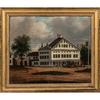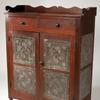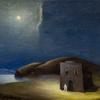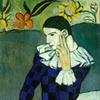Smithsonian Announces New Curatorial Appointments
- WASHINGTON, DC
- /
- November 15, 2021
The Smithsonian’s National Museum of Asian Art has named Diana Jocelyn Greenwold the inaugural Lunder Curator of American Art. Greenwold was appointed to this role in September 2021. The position is made possible by a grant from The Lunder Foundation and matching funds from Jacqueline B. Mars, Shelby and Frederick Gans, Paul Neely, Dr. and Mrs. Thomas P. Gage and the Friends of the National Museum of Asian Art. The position underscores the centrality of American art, especially the work of James McNeill Whistler, to the historical and artistic identity of the Freer Gallery of Art and the museum’s interpretation of Asian art.
In this role, Greenwold stewards the museum’s collection of American art, which dates largely to the late 19th century and includes significant works by Dwight Tryon, Thomas Wilmer Dewing, Abbott Thayer, John Singer Sargent and Winslow Homer. She is also responsible for the museum’s unparalleled selection of works by James McNeill Whistler, including the famous Peacock Room. Greenwold collaborates with the curatorial team and across departments to reflect on the collecting practices and networks of the museum’s founder Charles Lang Freer. As the museum prepares to celebrate its centennial in 2023 and embark on its next 100 years, Greenwold will play an important role in highlighting connections across cultures.
“Colleagues and I are delighted that Diana Jocelyn Greenwold has joined our curatorial team,” said Chase F. Robinson, the Dame Jillian Sackler Director of the museum. “Her expertise and perspective will strengthen our voice at a time of great opportunity for the museum as we approach our centennial.”
“I am thrilled to be joining the Smithsonian’s National Museum of Asian Art at such an exciting moment in the institution’s history,” Greenwold said. “I look forward to interpreting the iconic works in the collection in new ways to reach a wide array of visitors. Working with my colleagues, I hope to deepen the stories the museum can tell about America, Asia and the world.”
Greenwold specializes in late 19th- and early 20th-century American fine and decorative arts. She is particularly interested in stories of transnational exchange and the ways objects carry and transform culture. From 2014 to 2021, Greenwold served in various curatorial positions, ultimately as curator of American art at the Portland Museum of Art (PMA) in Portland, Maine. There, she oversaw the museum’s collection of over 11,000 American paintings, sculptures and decorative arts and was a core member of the team that reinstalled the PMA’s permanent collection in 2017. Her recent exhibitions include “Small Wonders: Rethinking American Arts and Crafts, 1880–1920” (2021), “Mythmakers: The Art of Winslow Homer and Frederic Remington” (2020) and “In the Vanguard: Haystack Mountain School of Crafts, 1950–69” (2019). At the PMA, Greenwold also spearheaded the multi-stage reinterpretation of the Winslow Homer Studio. She has recently published exhibition catalog essays about lace in Italy and the United States and Scandinavian designers in early 20th-century America. Greenwold received her doctorate in history of art from the University of California, Berkeley, and her Bachelor of Arts from Yale University.
The Smithsonian’s National Museum of Asian Art has named Sol Jung the inaugural Shirley Z. Johnson Assistant Curator of Japanese Art. Jung was appointed to this role in September 2021. The position is made possible by a landmark bequest from the late Shirley Z. Johnson, a pioneering collector, friend and trustee of the museum, distinguished attorney and philanthropist. The largest single gift to the museum since its founding, the bequest enables the museum to deepen the study of Japanese art, especially ceramics and metalwork, and to educate the public through new initiatives.
In this role, Jung stewards the museum’s collection of pre-modern, modern and contemporary ceramics, lacquer ware and metalwork, which together number over 3,000 works. Jung also collaborates with the curatorial team and across departments to contribute significantly to the museum’s Japan-related initiatives. As the museum prepares to celebrate its centennial in 2023 and embark on its next 100 years, Jung will play an important role in highlighting Japanese objects and their connections across cultures.
“Colleagues and I are excited that Sol Jung has joined our curatorial team,” said Chase F. Robinson, the Dame Jillian Sackler Director of the museum. “Her perspective and contributions will strengthen our voice at a time of great opportunity for the museum as we approach our centennial.”
“I am delighted to join the National Museum of Asian Art during such an exciting time as we approach its centennial,” Jung said. “I am grateful for the late Shirley Z. Johnson’s visionary gift, which supports the museum’s continued commitment to preserving and studying Japanese objects. I am especially honored to continue Ms. Johnson’s initiative to promote research on modern and contemporary Japanese metalwork. I look forward to working with my colleagues to expand our understanding of Japanese objects in relation to the greater context of Asian art history and culture.”
Jung specializes in Japanese art history with a focus on how transnational maritime trade affected Japan’s visual culture during the premodern period. Jung received her Bachelor of Arts with distinction in the history of art at the University of Pennsylvania and her Master of Arts in art and archaeology from Princeton University, where she successfully defended her doctoral degree at the end of October. Jung curated Princeton University Art Museum’s first thematic exhibition of Korean ceramics entitled “Korean Ceramics: From Archaeology to Art History.” She has examined the reception of Korean tea bowls, called kōrai jawan in Japan, during the 16th century. Fieldwork at several maritime settlement sites in Japan and analysis of period tea documents, literary texts and archaeological remains have informed her research, which has been supported by the Metropolitan Center for Far Eastern Art Studies and the Kyujanggak International Center for Korean Studies.



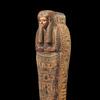

_Infinity_by_Santiago_Medina_PhotoCr100x100_c.jpg)


